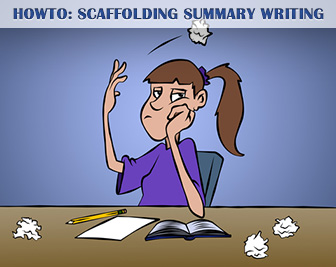Less is More? How to Teach Summary Writing


For the student, it offers them a chance to synthesize what they just read and sort out the ideas in their own words. For the teacher, it is a great way to assess the student’s comprehension of the material.
Although writing a summary can be quite a rigorous activity for English language learners, that should not discourage teachers from doing summary writing in their classrooms. Like any rigorous activity, with the right scaffolding, students can rise to the level of the activity and come out stronger.
There are many ways a teacher could scaffold writing summary. The process I share below, done in its entirety, touches on all of the four language skills: listening, reading, speaking and writing. Although the activities are very effective when done in the sequence below, they are very effective individually. When deciding which activities to use, the teacher must look at factors such as the level of the class and the class time constraints. It is best to do this sequence of a series of days.

The first step to writing a summary is to read the material to be summarized. There are many ways you could do this such as reading individually, reading in partners, or reading as a group.
For the most support, I recommend doing an interactive read-aloud first. This is where the teacher reads the material to the class using different voices, gestures, and facial expressions to facilitate the understanding of meaning of a story. During this process, it is recommended that the teacher stops at key moments throughout the story to offer explanations and/or to check for students’ comprehension.
Following the read-aloud, the students should read the material in pairs or individually to solidify their understanding of the material.
Once you have read the material, it helps to organize the ideas into a graphic organizer. This can help students get their ideas on to paper in a clear, organized format. It is recommended to have the students do this in a small group or in pairs so they have the support of others. If you don’t have one already, the internet is filled with free graphic organizers that you can print and use in your classroom!
Language Experience is a great way to get the students talking while also helping them construct a summary with the support of their classmates and the teacher. The final product is a great example to the students of what a summary should look like. It is also all student created so the students will take pride in what they have accomplished together and will have the confidence to do it individually in the future.
Here is how to do a language experience activity.
You have read the material, you have organized ideas using graphic organizers, and you have composed a group summary that acts as a great example for the students. It is now time to write the summary. How much scaffolding you add at this point will depend on you and your students. Here are some options.
This is the most important step of all. You went through all the steps scaffolding the summary writing process and the students produced great summaries that deserved to be shared. You can have each student read their summary to the class or read it to their partner. If you want to allow comments after reading, it is recommended to only comment on content at this point. If you want to do a peer-editing step before sharing, that would be the time to comment on grammar and syntax.
Sharing should not stop with members of the class; we need to share this accomplishment with other teachers, parents, and the community. Post your summaries around your classroom or your school that is visible for anyone who drops by for a visit.
This is a guest post by Keith Graham. Want to write a guest post? Contact us!